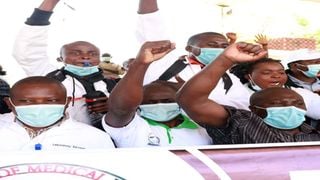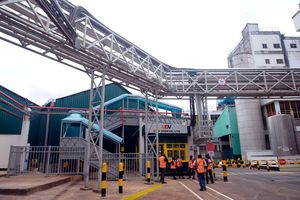
The Kenya National Union of Medical Laboratory Officers demonstrate in Nairobi on Wednesday.
| Dennis Onsongo | Nation Media GroupNews
Premium
Health sector in a crisis as medics, authorities fall out
Dark clouds are once again gathering over Kenya’s healthcare sector following a fresh fallout between the government and most cadres of medical workers fighting for their welfare.
Already, lab technicians and nurses are boycotting work after the national and county governments failed to address their grievances, while doctors and clinical officers have threatened to return to the streets after governors developed cold feet in the implementation of the agreements that ended their recent strikes.
That some governors have started firing striking medical staff has only made matters worse, with unions threatening to paralyse service delivery.
The Kenya Medical Practitioners, Pharmacists and Dentists Union (KMPDU)— representing 7,200 doctors who had inked a return-to-work formula with the government last week— says it is patiently waiting for additional emergency call allowances (now renamed doctors’ allowance) as agreed upon in 2017.
The union wants 116 doctors on contract given permanent jobs and unconditional release of all withheld salaries arising from their recent industrial action.
Fast-track funding
Treasury on the other hand is expected to fast-track funding to counties to procure comprehensive group life, last expense, enhanced work injury benefits and group personal accident cover as provided by the national insurer.
That, however, collapsed after the Council of Governors (CoG) said it was not tenable to meet the said agreements.
Governors said they were not properly consulted in the talks, adding that all counties should have been approached individually. As for clinical officers, they equally signed a return-to-work formula to have an increased risk allowance of Sh15,000 and that their stalled collective bargaining agreement would resume by end of February.
Among other things, the Kenya Union of Clinical Officers (KUCO), which has 8,000 members, agreed to talks with the Salaries and Remuneration Commission.
The government would also drop all cases presented to court following the strike notice issued on November 23 together with all disciplinary cases emanating from the strike.
The document signed by the Health CS Mutahi Kagwe and his Labour counterpart Simon Chelugui is, however, conspicuously missing the signature of representatives from the CoG despite President Kenyatta’s intervention. KUCO Chairman Peterson Wachira yesterday said it is unfortunate that they have to continue with the strike due to failure by governors to sign the return-to work-formula.
“It is the signing of the formula that was to call off the strike, which means that when left unsigned, then the strike is still in force. County governments have continued to victimise and sack our members even after members resumed duty,” he said.
He added that their strike would continue from midnight for as long as the formula remains unsigned by the CoG.
Firing nurses
The Kenya National Union of Nurses (KNUN), which represents 29,000 nurses, had agreed to a return-to-work formula offering them a Sh15, 000 risk allowance and a CBA by February this year.
But the pacts have remained in draft form after county governments and the ministries of Labour and Health refused to sign them. To make matters worse, some governors have already started firing nurses and advertising their jobs. Things are equally thick in labs after members of Kenya National Union of Medical Laboratory Officers began their strike on Wednesday.
The union with a membership of 10,000 is agitating for risk allowances as lab technicians are the first people to engage with the samples taken from patients.
Kisii Governor James Ongwae, who chairs CoG’s Human Resources Committee, said the health workers are unrealistic in their demands. “Health workers are well known for calling unnecessary strikes and demanding payment for work not done. If we must consider them again, we will not pay for the months they never worked,” he said.
Additional reporting by Benson Ayienda





